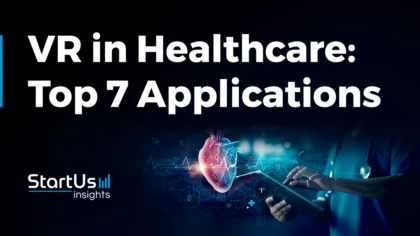Accelerate Productivity in 2025
Reignite Growth Despite the Global Slowdown
Virtual reality (VR) is transforming healthcare by improving medical training, patient care, and mental health support through immersive, interactive experiences. In medical training and simulation, VR allows healthcare professionals to practice complex procedures and refine skills in risk-free environments, which advances their competence and confidence. Physical rehabilitation programs incorporate VR to create engaging exercises that improve patient motivation and recovery outcomes.
For patient education and communication, VR offers visualizations that help patients understand diagnoses and treatment options, fostering better-informed healthcare decisions. Additionally, VR applications in mental health support provide therapeutic environments that alleviate anxiety, depression, and PTSD symptoms, making mental health care more accessible and effective. As VR technology evolves, its applications in healthcare continue to expand, opening new pathways for personalized and innovative patient-centered care.
Why should you read this report?
- Gain in-depth insights into the top 7 use cases of VR in healthcare
- Learn about three practical use cases for each use case
- Meet 10 innovative startups advancing these applications

Key Takeaways
- Medical Training and Simulation
- Use Cases:
- Surgical Training
- Anatomy Education
- Startup to Watch: i3 Simulations
- Use Cases:
- Physical Rehabilitation
- Use Cases:
- Upper Limb Rehabilitation
- Balance and Gait Training
- Startup to Watch: RefitVR
- Use Cases:
- Patient Education and Communication
- Use Cases:
- Pre-Operative Education
- Immersive Demonstrations
- Startup to Watch: Wide Awake VR
- Use Cases:
- Mental Health Support
- Use Cases:
- Exposure Therapy
- Cognitive Behavioral Therapy
- Startup to Watch: AnamVR
- Use Cases:
- Pain Management
- Use Cases:
- Distraction Therapy
- Phantom Limb Pain Simulation
- Startup to Watch: Calmica
- Use Cases:
- Remote Consultation
- Use Cases:
- Remote Diagnosis
- Therapeutic Applications
- Startup to Watch: Dancing Mind
- Use Cases:
- Surgical Planning and Visualization
- Use Cases:
- Collaborative Planning and Training
- Spatial Understanding of Anatomy
- Startup to Watch: Kinomatic
- Use Cases:
FAQs: Applications of VR in Healthcare
1. How is virtual reality used in healthcare?
Virtual reality (VR) is transforming healthcare by providing immersive, interactive experiences across various applications. In medical training and simulation, VR creates realistic, risk-free environments where healthcare professionals practice complex procedures. Physical rehabilitation programs integrate VR to engage patients in targeted exercises, promoting better recovery outcomes.
Additionally, VR supports patient education by visualizing medical conditions and treatment plans, which helps patients make informed decisions. Mental health care also benefits, as VR offers virtual therapeutic environments to treat conditions like anxiety, depression, and PTSD, enhancing accessibility and treatment effectiveness.
2. What is the future of virtual healthcare?
The future of virtual healthcare involves expanding VR’s role in personalized, accessible, and scalable patient care. Emerging VR applications will refine real-time monitoring, remote diagnosis, and rehabilitation, streamlining care delivery. Additionally, AI integration with VR will enhance adaptive learning in medical training and enable more personalized mental health therapies. As VR technology advances, its potential for telemedicine will grow, enabling immersive remote consultations that simulate in-person experiences, ultimately creating a more interactive and efficient healthcare ecosystem.
Where is this Data from?
StartUs Insights provides data through its comprehensive Discovery Platform, which covers 4.7+ million startups, scaleups, and tech companies globally, as well as 20K+ emerging technologies & trends. The platform excels in startup and technology scouting, trend intelligence, and patent searches, offering a detailed view of the innovation landscape.
For this report, we analyzed technologies within specific industries using the trend intelligence feature. During this research, we identified patterns and trends, pinpointing relevant use cases and the startups developing solutions for each. More capabilities and details are available at StartUs Insights Discovery Platform.
Top 7 Applications of VR in Healthcare [2025 & Beyond]
1. Medical Training and Simulation
VR enables virtual operating rooms, which medical practitioners use to build practical knowledge and hands-on skills in safe, repeatable, and controlled environments. It is also used to represent virtual human body anatomy allowing medical practitioners to practice dissecting the bodies, get a close view of the internal organs, and understand the spatial relationships among the anatomical structures.
VR is important in simulating emergencies like cardiac arrest, trauma, and multiple-casualty incidents. These high-stakes scenario simulations train doctors to perform efficiently in real-life emergencies. It improves team collaboration and coordination and reduces the time lost in confusion in emergencies. As VR is accessible remotely, it allows remote training and mentoring worldwide. Medical students from different parts of the world learn using VR from specialized experts in the field.
Dive Deeper:
- Noteworthy Example: MediSim has established an advanced immersive VR medical training center at SRIHER, Chennai, benefiting over 4,000 students. They also opened a VR nurse training lab in partnership with KD Hospital.
- Financial Landscape: The average funding for startups using VR for medical simulations and training is USD 7.6 million.
Startup to Watch: i3 Simulations
i3 Simulations develops a VR platform that offers realistic, research-backed medical training curated by healthcare experts. Its resuscitation VR module places learners in high-pressure emergencies, which sharpens essential decision-making skills. PeTIT VR enables multidisciplinary teams to practice crucial interventions within a realistic yet risk-free virtual space under instructor supervision.
Another product SimGym provides customized 3D emergency and clinic environments, which allows VR training in realistic scenarios. Further, the ENT Surgery VR platform allows virtual temporal bone surgery on a patient requiring ENT care. This allows the trainee to test their anatomical knowledge and surgical skills. The simulation software provides instructors with tools to customize 3D clinical and emergency environments, which creates authentic scenarios for immersive training. The platform also includes customizable dashboards for personalized tracking of individual and team progress.
2. Physical Rehabilitation
Technologies like VR headsets, motion tracking, haptic feedback, etc. are used for balance and gait training, distraction therapy, cognitive rehabilitation, upper limb rehabilitation, etc. Using VR in the rehabilitation process assists the patients to get a sense of how they will be performing in the real world. This builds confidence and speeds up the process. For example, patients practice walking and balancing in a virtual, yet real world using treadmill and balance platforms with VR integration.
VR rehabilitation often incorporates gamified elements such as reaching objects or navigating virtual obstacles, which is important in cases like strokes or similar neurological events, where patients practice reaching, grasping, coordinating, and refining motor skills. Additionally, VR enables the combination of cognitive tasks in physical environments. Patients make decisions or solve problems within the virtual environment, and improve cognitive skills like memory, attention, and problem-solving alongside physical rehabilitation.
Dive Deeper:
- Noteworthy Example: XRHealth offers FDA-cleared virtual reality physical therapy solutions for various conditions. They provide a platform that allows therapists to customize treatment plans, monitor progress, and deliver engaging rehabilitation sessions remotely. Their VR therapy is being used by major companies like ByteDance to offer employee benefits.
- Financial Landscape: The average funding for startups using VR for physical rehabilitation is USD 3.74 million.
Startup to Watch: RefitVR
RefitVR creates a VR platform that integrates advanced data analytics to deliver an all-encompassing care solution for patients and healthcare providers. The VR system is particularly useful for addressing musculoskeletal issues, post-injury or post-surgical rehabilitation, and rheumatological conditions. Patients engage in interactive games tailored to their abilities, with motion sensors tracking exercise accuracy and progress. The platform continuously adjusts difficulty levels throughout therapy to align with the patient’s evolving capabilities, which ensures a personalized and effective rehabilitation experience.
3. Patient Education and Communication
Using VR in patient communication and education entails pre-operative education, immersive demonstration, and condition and disease education, among others. Virtual representations of complex situations improve the patient’s understanding of the situation, reduce anxiety, accelerate preparedness, etc. For example, patients undergoing open heart surgery use a VR demonstration to understand how a surgeon with operate on their specific anatomy, prepare them for the process, and make them aware of the outcome.
It is also useful for educating patients’ families about the condition, the recovery process, and the required care-giving. VR is also used for 3D simulations of disease progression like plaque buildup or how cancerous cells spread. Technologies like interaction tools, motion tracking, 3D modeling, visualization software, etc. are used to enable virtual representation for patient communication and education.
Dive Deeper:
- Noteworthy Example: HintVR is a platform for VR Training, build by 8chili. It transforms workforce development through immersive simulation. This approach cuts costs by making high-quality VR training accessible to more companies. HintVR provides a VR training library along with a revenue-sharing model.
- Financial Landscape: The average funding for startups using VR for patient communication and education is USD 13.4 million.
Startup to Watch: Wide Awake VR
WAVR offers a VR platform for patients undergoing minor surgical and painful medical procedures, such as hand and cosmetic surgeries, dermatology treatments, pediatrics, and oncology. This immersive technology reduces the need for painkillers and anti-anxiety medications both during and after procedures by replacing traditional sedation with virtual reality and multimedia engagement. WAVR’s patent-pending platform establishes patient safety protocols for fully interactive, awake procedures. The surgeries typically last 10 to 20 minutes, with patients spending under an hour at the surgical facility. The VR kit includes a headset, tablet, case, and other necessary components, with all pre- and post-procedure instructions delivered digitally.
4. Mental Health Support
VR improves the quality of mental health treatment by introducing alternate, controlled scenarios, which are specific and targeted for various mental health conditions. For instance, VR improves engagement, cognitive restructuring, skill practice, and social skills training in cognitive behavioral therapy (CBT) by providing an interactive environment. Similarly, it improves the outcome of exposure therapy, used in anxiety disorder, phobias, and PTSD by incorporating gradual exposure, controlled environment, repeatability, and real-time monitoring.
Additionally, using haptic feedback devices and isometric sensors, VR improves the treatments of conditions like schizophrenia. Further, VR enables immersive relaxation and meditation environments which reduce stress and manage anxiety. It also simulated traumatic scenarios for PTSD patients, which allows patients to process and overcome trauma in a safe environment.
Dive Deeper:
- Noteworthy Example: XRHealth provides a virtual reality platform that offers remote therapy for mental health and substance abuse, allowing patients to receive counseling and support while using VR technology in the comfort of their homes. The platform is noted for its effectiveness during the COVID-19 pandemic in addressing increased mental health challenges.
- Financial Landscape: The average funding for startups using VR for mental health support is USD 5 million.
Startup to Watch: AnamVR
AnamVR is a hybrid virtual reality application that supports individuals in improving their mental well-being through immersive experiences. Combining smartphone-based VR, gamification, psychoeducation, and CBT, AnamVR guides users through evidence-based exercises designed to build resilience and coping skills. Accessible on mobile devices and compatible with budget-friendly VR headsets like Google Cardboard, the app transports users to calming environments and provides a secure space for healing and growth. The application features a mood log for tracking emotional patterns and a Relief Hub for meditations tailored to address various mood and anxiety issues. It also provides interactive lessons on CBT fundamentals.

5. Pain Management
VR is used in acute and chronic pain management, burn care, phantom limb pain simulations, and more. It also assists with pre-operative pain and cancer-related pain. The integration of VR is focused on distraction methods and manipulating neurobiological effects. The distraction created by the virtual environment decreases pulse rate, anxiety, and discomfort from the pain. It influences the pain modulation pathways in the brain with the help of a 3D, computer-generated environment that engages multiple senses and distracts people from the pain. Some primary devices used include head-mounted displays, audio systems, and mobile VR platforms, among others
Dive Deeper:
- Noteworthy Example: AppliedVR built RelieVRx, which offers a fully immersive virtual reality (VR) experience for managing chronic lower back pain (CLBP). It serves as a cost-effective, non-pharmacologic adjunctive therapy clinically proven to significantly reduce pain intensity and interference. Patients using RelieVRx undergo a 56-session, multimodal program, featuring daily VR sessions that address the bio-psycho-social aspects of pain.
- Financial Landscape: The average funding for startups using VR for pain management is USD 5.3 million.
Startup to Watch: Calmica
Calmica builds a virtual reality solution for painful therapies. The platform comes with an application for renting VR headsets and accessing VR content designed for pain management. The comprehensive content library contains customized digital content that distracts adults and children before and during treatments. The service also includes rental VR equipment compatible with the Calmica app, which ensures access to pain-relief experiences all in one platform.
6. Remote Consultation
VR facilitates a more intuitive mode of interaction and improves communication between healthcare providers and patients. With technologies like 3D anatomical models and real-time data visualization, doctors provide more accurate diagnosis and treatment planning. It also assists the patients with a better understanding, interpretation, and analysis of the situation. Moreover, VR facilitates collaboration between doctors in different regions. It expands access to specialized care in underserved areas and improves surgical outcomes through real-time expert guidance.
Technologies like cloud computing, AI, and machine learning, along with high-speed internet etc are used for data processing, data sharing, and predictive modeling to improve the VR experience. Further, various telemedicine platforms are powered by VR to facilitate and improve the remote consultation experience.
Dive Deeper:
- Noteworthy Example: Rey is working to improve mental health and wellness by combining cognitive behavioral therapy, talk therapy, medication, and clinically validated VR-based tech tools. Powered by OxfordVR, a spin-out of Oxford University that delivers immersive treatment tools, Rey is helping care teams bring treatments directly to members’ homes.
- Financial Landscape: The average funding of the startups using VR for remote healthcare consultation is USD 16.9 million.
Startup to Watch: Dancing Mind
Dancing Mind offers virtual reality and digital therapeutics software solutions. The virtual reality-as-a-platform comes with digital mediums and online patient activity monitoring. Combining VR headsets alongside patient management systems, the company provides features such as remote therapy, home-based digital rehabilitation, and cognitive training. It serves stroke and traumatic brain injury survivors through motivating rehabilitation journeys. Additionally, it offers standardized cognitive training for individuals with dementia and mild cognitive impairment. The software solution also supports children with ADHD and autism by delivering specialized care.
7. Surgical Planning and Visualization
VR provides immersive, 3D views of the patient’s anatomy, which allows the surgeons to better understand the complex structures and spatial layout. Such spatial layouts assist the doctors in locating unusual anatomical variations, that might complicate surgeries. VR also provides detailed mapping of blood vessels and tumors. It improves preoperative planning and precision and reduces risk by anticipating potential complications in the operations. Using VR at the preparatory level also improves the outcome of multi-disciplinary collaboration, where multiple specialists like surgeons, radiologists, anesthesiologists etc, need to participate.
Dive Deeper:
- Noteworthy Example: ImmersiveTouch provides integrated virtual reality (VR) solutions such as the Immersive view surgical plan (IVSP) platform, which enables surgeons to rapidly transform patient imaging data (CT/MR) into high-resolution 3D models for personalized surgical planning. This technology enhances surgical precision, reduces operating room time, and improves pre-operative training and patient engagement through realistic simulations.
- Financial Landscape: The average funding for startups using VR for surgical planning and visualization is USD 37.1 million.
Startup to Watch: Kinomatic
Kinomatic builds a proprietary virtual reality application for orthopedic practices with customized surgical planning. It enables the surgeons to visualize a detailed 3D model of a patient’s anatomy and plan each aspect of the procedure before entering the operating room. The process begins with a high-resolution, low-dose CT scan from hip to ankle, which is transformed into a 3D image using advanced AI software.
A biomedical engineer then performs landmarking, taking extensive measurements to give surgeons the data needed for precise planning. Biomechanical alignment is carefully assessed to maximize natural joint movement, and implant sizing is optimized from 30,000+ options for a perfect fit, which minimizes intraoperative adjustments. Final implant placement is planned to match natural joint biomechanics. Surgeons then review the custom 3D plan in VR to refine a minimally invasive approach, which reduces operating time, and postoperative pain and supports a smoother recovery.
Act Now to Take Advantage of Top VR-led Healthcare Technologies
Top investors like Innovate UK, Startup Wise Guys, Techstars, XR Startup Program, and Innosuisse, support startups focusing on VR applications in the healthcare industry. They provide crucial funding that drives innovation. This funding majorly spans seed, pre-seed, angel, and early stage VC/series A rounds. Whereas, the average funding per round stands at USD 3.7 million, supporting early-stage startups developing VR-powered solutions advancing healthcare.
Take immediate action on the top emerging healthcare technologies to stay ahead in the industry. StartUs Insights empowers you to uncover hidden opportunities among 4.7 million startups and tech companies, alongside insights into 20K+ technologies and trends. Our AI-powered, real-time database provides unparalleled access to solutions that are not available elsewhere, ensuring you always lead in innovation.
Major companies like Samsung, Nestlé, and Magna rely on our tools to spearhead trends and optimize operations. Dive into unmatched data and benefit from a 360-degree industry view for actionable insights. Get in touch with us now to discover how our innovation intelligence can elevate your strategic initiatives.
Discover All VR-led Healthcare Technologies & Startups!







